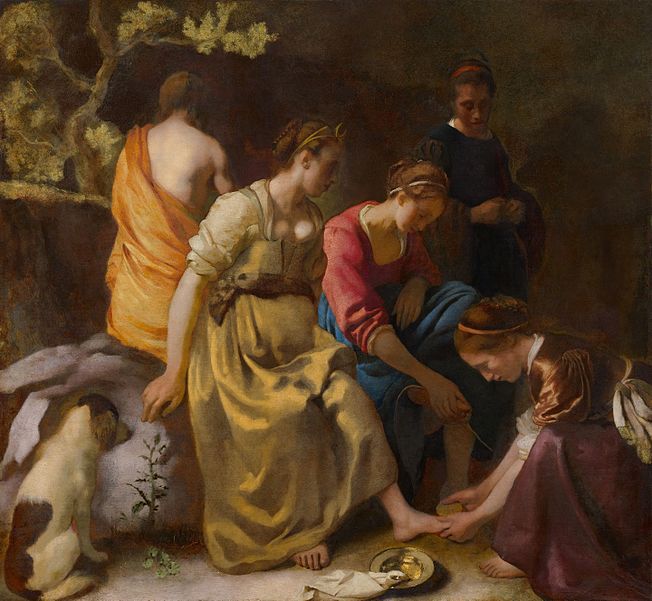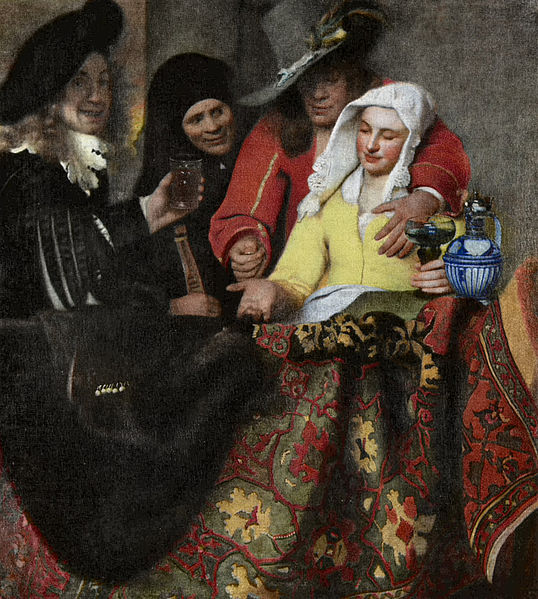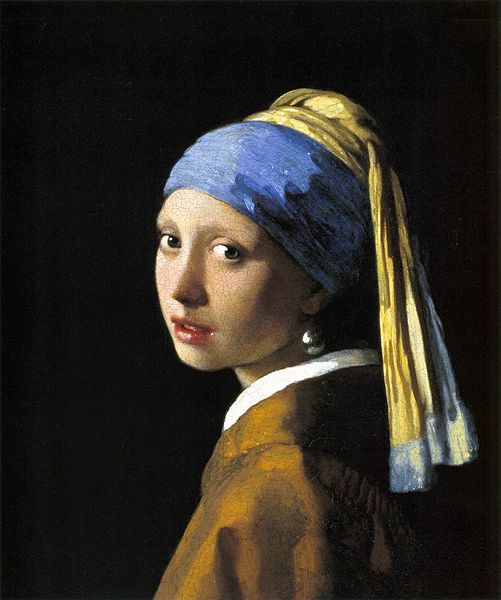Friday, April 18, 2014
Mauritshuis Presents The Young Vermeer
The three earliest paintings by Johannes Vermeer (1632-1675) were on display at the Mauritshuis in The Hague from 12 May until 22 August 2010. It was the first time these works by the well-loved painter from the Dutch Golden Age had been shown together in the Netherlands. These early painting are atypical for Vermeer. They do not represent richly decorated interiors filled with alluring women; instead he painted three remarkably large works depicting a mythological scene, a story from the Bible and a rather daring scene from everyday life. Nonetheless, every one of them reveals Vermeer’s hand and his interest in capturing stillness and the fall of light.
The display was organized in close collaboration with The National Gallery of Scotland in Edinburgh and the Gemäldegalerie Alte Meister in Dresden,
Seeking His Own Style
Vermeer started his career making history paintings, representing stories from the Bible and classical mythology. According to academic theory at the time, this was the highest form of painting. As a history painter Vermeer could hope to achieve the greatest respect, but for him this did not prove to be the most productive course. It was only after a period of two to three years, during which he sought his own style, that he started to concentrate on painting the atmospheric and lavish interior scenes for which he became so famous. The display The Young Vermeer brings this period of experimentation to life.
The Mythological Story
Diana and her Nymphs from the Mauritshuis’s own collection is probably the first painting Vermeer ever made. He would have been around 21 years old at the time. The picture exudes a sense of calm and shows the goddess and her nymphs at rest, a popular subject in seventeenth-century Dutch painting.
The Bible Scene
Vermeer’s second known work is Christ in the House of Martha and Mary from the collection of The National Gallery of Scotland in Edinburgh. Measuring 158.5 cm x 141.4 cm, this Bible scene is his largest painting and was likely painted in 1654-55. The colours used in this work are very similar to those in Diana and her Nymphs, particularly the striking shades of dark blue, ochre yellow, violet and red.
The Genre Piece
The third early Vermeer is called The Procuress and comes from the Gemäldegalerie Alte Meister in Dresden. Vermeer painted this work in 1656 at the age of 24. Few paintings by Vermeer are as daring as this depiction of love for sale. The man who looks out from the left of the painting is likely a self-portrait, the only known example.
Vermeer and the Mauritshuis
The Mauritshuis has a strong connection with Vermeer, with three of the artist’s paintings in its permanent collection. View of Delft was acquired in 1822, shortly after the museum opened its doors, while Diana and her Nymphs followed in 1876 (having originally been purchased as a work by Nicolaes Maes). In 1903 the Mauritshuis received
Girl with a Pearl Earring,
which had been on loan to the museum since 1881, as a bequest from the collector A.A. des Tombe. Every year this collection of Vermeers, which is exceptional both in terms of number and subject matter, draws thousands of visitors from around the world.
In 1996, the Mauritshuis organised the first large-scale survey of Vermeer’s work. No fewer than 23 of the artist’s paintings, two-thirds of his entire output, were shown together in The Hague. The Procuress from Dresden was not included in that exhibition. In 2005, the museum was able to display another work not in that exhibition to the public:
The Art of Painting
from the Kunsthistorisches Museum in Vienna. Now in 2010 the Mauritshuis is bringing the young Vermeer into the limelight for the first time by showing his three earliest works.
Publication
A book (of around 100 pages) written by Edwin Buijsen, Head of Collection at the Mauritshuis and curator of The Young Vermeer, accompanied the display. It considers Vermeer’s three early works in detail and includes extensive illustrations. It also looks at the rediscovery of Vermeer’s early work at the beginning of the twentieth century. This attractive publication is available in Dutch and English

_Vermeer_-_Christ_in_the_House_of_Martha_and_Mary_-_Google_Art_Project.jpg/518px-Johannes_(Jan)_Vermeer_-_Christ_in_the_House_of_Martha_and_Mary_-_Google_Art_Project.jpg)



